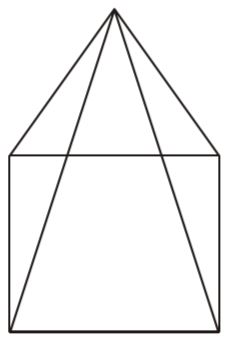Mensuration
- A right pyramid stands on a base 16 cm square and its height is 15 cm. The area (in cm2) of its slant surface is
-
View Hint View Answer Discuss in Forum

Lateral surface area = 1 × perimeter of base × slant height 2
[∵ Slant height = √8² + 15² = √64 + 25 = √289 = 17 cm]∴ Required area = 1 × 64 × 17 = 544 sq.cm. 2 Correct Option: B

Lateral surface area = 1 × perimeter of base × slant height 2
[∵ Slant height = √8² + 15² = √64 + 25 = √289 = 17 cm]∴ Required area = 1 × 64 × 17 = 544 sq.cm. 2
- If the altitude of a right prism is 10 cm and its base is an equilateral triangle of side 12 cm, then its total surface area (in cm²) is
-
View Hint View Answer Discuss in Forum
Total surface area = Perimeter of base ×height + 2 × area of base
= 36 × 10 + 2 × √3 × 12 × 12 4
= 360 + 72√3
= 72 (5 + √3) sq. cmCorrect Option: D
Total surface area = Perimeter of base ×height + 2 × area of base
= 36 × 10 + 2 × √3 × 12 × 12 4
= 360 + 72√3
= 72 (5 + √3) sq. cm
- A right pyramid stands on a square base of diagonal 10√2 cm. If the height of the pyramid is 12 cm, the area (in cm2) of its slant surface is
-
View Hint View Answer Discuss in Forum

Side of square base = 1 × 10√2 = 10 cm √2
Slant height = √5² + 12² = 13 cm∴ Area of the lateral surface = 1 × perimeter of base × slant height 2 = 1 × 40 × 13 = 260 sq.cm 2 Correct Option: D

Side of square base = 1 × 10√2 = 10 cm √2
Slant height = √5² + 12² = 13 cm∴ Area of the lateral surface = 1 × perimeter of base × slant height 2 = 1 × 40 × 13 = 260 sq.cm 2
- A right prism stands on a base 6 cm equilateral triangle and its volume is 81√3cm³. The height (in cm) of the prism is
-
View Hint View Answer Discuss in Forum
Area of the base of prism = √3 × 6 × 6 = 9√3 sq.cm. 4
∴ Volume = Area of base × height
⇒ 81√3 = 9√3 sq.cm.⇒ height = 81√3 = 9 cm 9√3 Correct Option: A
Area of the base of prism = √3 × 6 × 6 = 9√3 sq.cm. 4
∴ Volume = Area of base × height
⇒ 81√3 = 9√3 sq.cm.⇒ height = 81√3 = 9 cm 9√3
- The base of a right pyramid is an equilateral triangle of side 10√3 cm. If the total surface area of the pyramid is 270√3 sq. cm, its height is
-
View Hint View Answer Discuss in Forum

AB = 10√3 cm
BE = 5√3 cm
AE = √(10√3)² - (5√3)²
= √225 = 15 cmOE = 1 × 15 = 5 cm. 3
Let the height of pyramid be h cm, then
Slant height = √h² + 5² = √h² + 25
Now, Total surface area = Area of the 3 faces + Area of base= 3 
1 base × slantheight 
+ Area of the base 2 Total surface area = 1 × (perimeter of base) × (slant height) + Area of base [base of all the 3 triangular faces is the edge of the equilateral triangle]. 2 ⇒ 270√3 - 1 × 30√3 × √h² + 25 + √3 × (10√3)² 2 4
⇒ 270√3 - 15√3√h² + 25 + 75√3
⇒ 15√3√h² + 25 = 195√3
⇒√h² + 25 = 13
⇒ h² + 25 = 169
⇒ h² = 169 – 25 = 144
⇒ h = 144 = 12 cmCorrect Option: D

AB = 10√3 cm
BE = 5√3 cm
AE = √(10√3)² - (5√3)²
= √225 = 15 cmOE = 1 × 15 = 5 cm. 3
Let the height of pyramid be h cm, then
Slant height = √h² + 5² = √h² + 25
Now, Total surface area = Area of the 3 faces + Area of base= 3 
1 base × slantheight 
+ Area of the base 2 Total surface area = 1 × (perimeter of base) × (slant height) + Area of base [base of all the 3 triangular faces is the edge of the equilateral triangle]. 2 ⇒ 270√3 - 1 × 30√3 × √h² + 25 + √3 × (10√3)² 2 4
⇒ 270√3 - 15√3√h² + 25 + 75√3
⇒ 15√3√h² + 25 = 195√3
⇒√h² + 25 = 13
⇒ h² + 25 = 169
⇒ h² = 169 – 25 = 144
⇒ h = 144 = 12 cm

